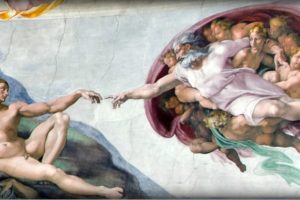As a student devoted to the intersection of theology and literature I’m always assessing ways in which literature accomplishes theological work and how theological thought appears in literary form. Most often these points of conversion occur by means of metaphor. To refresh your memory, metaphor is a kind of comparison in which one thing is described as another. Metaphor can be as colloquial as “love is war” or lengthy and complex underpinning an entire narrative. As I’ve read classical philosophy, early Christian theology, and medieval to modern literature I’ve observed many of the same metaphors recycle over the centuries, each author augmenting them for their own design. These ever-persisting metaphors depend upon common human experience— as universal as our experience of gravity. And, indeed, the experience of gravity or one’s weight reappears as a metaphor to characterize the movement of the soul and desire, either upwards or downwards, depending on your center of gravity.
Plato’s dialogues are riddled with myths on the soul. In Phaedrus, Socrates explains how the soul suffers in the flesh, weighed down by the body. The physical mass of the body cannot ascend to spiritual contemplation from which the soul fell. Socrates preaches that through the restraint of the passions and the practice of philosophy, the soul may regain its wings to rejoin the heavenly ranks. The soul’s desire, to contemplate the heavenly forms, is impeded by gravity, a fleshly existence which binds the soul to the earth. Weight, in this case, works against the movement of the soul.
St. Augustine appropriates this metaphor of gravity from Plato’s vision of the soul’s journey and maps it onto the Christian desire for God. He writes in the Confessions:
A body by its weight tends to move towards its proper place. The weight’s movement is not necessarily downward, but to its appropriate position: fire tends to move upwards, a stone downwards. They are acted on by their respective weights; they seek their own place. Oil poured under water is drawn up to the surface on top of the water. Water poured on top of oil sinks below the oil. They are acted on by their respective densities, they seek their own place. Things which are not in their intended position are restless. Once they are in their ordered position, they are at rest. My weight it my love. Wherever I am carried, my love is carrying me. (XIII.ix)
St. Augustine makes a few adjustments to the metaphor. Rather than the body acting as a weight upon the soul, the soul’s love is one’s weight. Furthermore, love determines the center of gravity or the point of attraction for the soul. Gravity is comparable to desire, the force which propels the soul forward toward its end. If the soul loves God, the gravity of desire draws the soul upward until finding perfect rest in Him.
Dante continues to develop St. Augustine’s metaphor in the Commedia through the word punto, meaning “point.” When the pilgrim descends to the very depths of Hell, he beholds the distorted face of Dis, the prince of Hell, the “evil worm,” who sits at the “point toward which the weights all move from every direction” (Inf. 34. 108, 110-111). Satan’s seat in the center of gravity not only places him furthest from the presence of God, but casts him as the figurehead of rebellion against the love of God as he attracts to himself all who rejected the love of God for a lesser good. This “punto” wherein Satan sits directly opposes the heavenly “punto” where the presence of God emanates in the Empyrean of Paradiso (Par. 28.16, 25, 42). The poet’s vision of the cosmos distinguishes between these two points of attraction each yielding different teleological outcomes: damnation or blessedness. Dante’s ascent of Mount Purgatory is punctuated with moments where his soul shedding the burdens of sin, feels lighter. As his soul is corrected through the practice of repentance and purification the pilgrim gravitates with increasing momentum toward God. His passage through each terrace of Purgatory prepares his soul for heavenly flight.
This metaphor has continued to developed a rich theological resonance as later thinkers such as George MacDonald and C.S. Lewis have created their own variations. MacDonald’s short story, “The Light Princess” tells the tale of a princess so light she would simply float away were it not for the diligence of the royal staff who by various contraptions and designs kept her earth-bound. It is not until the princess learns to love that the curse of her weightlessness falls. And so does she, but quite firmly upon the ground. Love is a gravity which keeps us steady. Lewis, a reader of Plato, St. Augustine, and Dante likewise adapts this image of the soul’s motion toward its end in the final chapters of The Last Battle. The company of Kings and Queens, Talking Beasts, and the other creatures of Narnia thunder across fields and valleys running so hard, so fast, their running turns to near flight— “Further up! Further in!” Spurred by desire, they race toward rest in Aslan’s country.
So why does metaphor matter? Metaphor is more than decoration. Metaphor matters because it works to deepens our understanding of an idea and, in this case, tethers a truth about the soul’s desire to our embodied experience as human beings. Metaphor works to bridge the gap between the mind and the body so that the next time you unload your heavy book bag, take a swing on a swing set, or race to greet a friend at the airport you are reminded of your soul and are led to consider its weight.





Leave a Reply
Your email is safe with us.